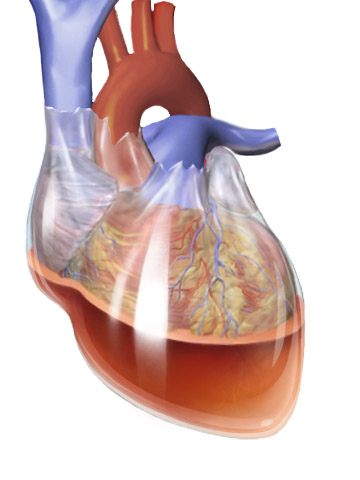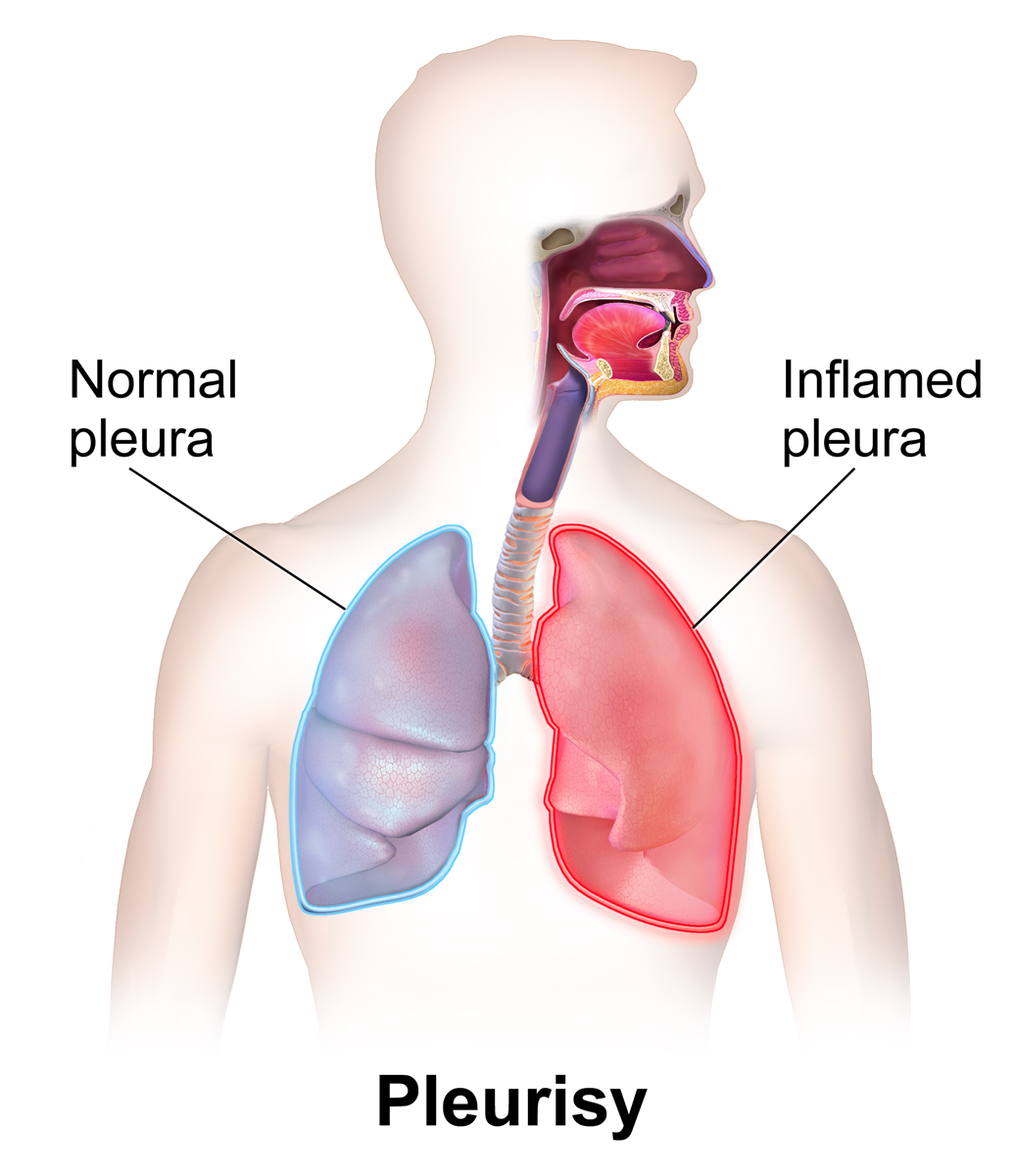|
Dressler's Syndrome
Dressler syndrome is a secondary form of pericarditis that occurs in the setting of injury to the heart or the pericardium (the outer lining of the heart). It consists of fever, pleuritic pain, pericarditis and/or pericardial effusion. Dressler syndrome is also known as postmyocardial infarction syndrome and the term is sometimes used to refer to post-pericardiotomy pericarditis. It was first characterized by William Dressler at Maimonides Medical Center in 1956. It should not be confused with Dressler's syndrome of haemoglobinuria named for Lucas Dressler, who characterized it in 1854. Presentation Dressler syndrome was historically a phenomenon complicating about 7% of myocardial infarctions, but in the era of percutaneous coronary intervention, it is very uncommon. The disease consists of persistent low-grade fever, chest pain (usually pleuritic), pericarditis (usually evidenced by a pericardial friction rub, chest pain worsening when recumbent, and diffuse ST elevation w ... [...More Info...] [...Related Items...] OR: [Wikipedia] [Google] [Baidu] |
Drug Reaction With Eosinophilia And Systemic Symptoms
Drug rash with eosinophilia and systemic symptoms or drug reaction with eosinophilia and systemic symptoms (DRESS), also termed drug-induced hypersensitivity syndrome (DIHS), is a rare reaction to certain medications. It involves primarily a widespread skin rash, fever, swollen lymph nodes, and characteristic blood abnormalities such as an abnormally high level of eosinophils, low number of platelets, and increased number of atypical white blood cells (lymphocytes). DRESS usually involves damage to the internal organs via inflammation and the syndrome has about a 1.2-7% mortality rate. Treatment consists of stopping the offending medication and providing supportive care. Systemic corticosteroids are commonly used as well but no controlled clinical trials have assessed the efficacy of this treatment. DRESS is classified as one form of severe cutaneous adverse reactions (SCARs). In addition to DRESS, SCARs includes four other drug-induced skin reactions: the Stevens–Johnson ... [...More Info...] [...Related Items...] OR: [Wikipedia] [Google] [Baidu] |
Pericardial Effusion
A pericardial effusion is an abnormal accumulation of fluid in the pericardial cavity. The pericardium is a two-part membrane surrounding the heart: the outer fibrous Connective tissue, connective membrane and an inner two-layered serous membrane. The two layers of the serous membrane enclose the pericardial cavity (the potential space) between them. This pericardial space contains a small amount of pericardial fluid, normally 15-50 mL in volume. The pericardium, specifically the pericardial fluid provides lubrication, maintains the anatomic position of the heart in the chest (levocardia), and also serves as a barrier to protect the heart from infection and inflammation in adjacent tissues and organs. By definition, a pericardial effusion occurs when the volume of fluid in the cavity exceeds the normal limit. If large enough, it can compress the heart, causing cardiac tamponade and obstructive shock. Some of the presenting symptoms are shortness of breath, chest pain, chest pressu ... [...More Info...] [...Related Items...] OR: [Wikipedia] [Google] [Baidu] |
Corticosteroids
Corticosteroids are a class of steroid hormones that are produced in the adrenal cortex of vertebrates, as well as the synthetic analogues of these hormones. Two main classes of corticosteroids, glucocorticoids and mineralocorticoids, are involved in a wide range of physiological processes, including stress response, immune response, and regulation of inflammation, carbohydrate metabolism, protein catabolism, blood electrolyte levels, and behavior. Some common naturally occurring steroid hormones are cortisol (), corticosterone (), cortisone () and aldosterone () (cortisone and aldosterone are isomers). The main corticosteroids produced by the adrenal cortex are cortisol and aldosterone. The etymology of the '' cortico-'' part of the name refers to the adrenal cortex, which makes these steroid hormones. Thus a corticosteroid is a "cortex steroid". Classes * Glucocorticoids such as cortisol affect carbohydrate, fat, and protein metabolism, and have anti-inflam ... [...More Info...] [...Related Items...] OR: [Wikipedia] [Google] [Baidu] |
Non-steroidal Anti-inflammatory Drug
Non-steroidal anti-inflammatory drugs (NSAID) are members of a therapeutic drug class which reduces pain, decreases inflammation, decreases fever, and prevents blood clots. Side effects depend on the specific drug, its dose and duration of use, but largely include an increased risk of gastrointestinal ulcers and bleeds, heart attack, and kidney disease. The term ''non-steroidal'', common from around 1960, distinguishes these drugs from corticosteroids, another class of anti-inflammatory drugs, which during the 1950s had acquired a bad reputation due to overuse and side-effect problems after their introduction in 1948. NSAIDs work by inhibiting the activity of cyclooxygenase enzymes (the COX-1 and COX-2 isoenzymes). In cells, these enzymes are involved in the synthesis of key biological mediators, namely prostaglandins, which are involved in inflammation, and thromboxanes, which are involved in blood clotting. There are two general types of NSAIDs available: non-selec ... [...More Info...] [...Related Items...] OR: [Wikipedia] [Google] [Baidu] |
Postcardiotomy Syndrome
Postpericardiotomy syndrome (PPS) is an immune phenomenon that occurs days to months (usually 1–6 weeks) after surgical incision of the pericardium (membranes encapsulating the human heart). PPS can also be caused after a trauma, a puncture of the cardiac or pleural structures (such as a bullet or stab wound), after percutaneous coronary intervention (such as stent placement after a myocardial infarction or heart attack), or due to pacemaker or pacemaker wire placement. Signs and symptoms The typical signs of post-pericardiotomy syndrome include fever, pleuritis (with possible pleural effusion), pericarditis (with possible pericardial effusion), occasional but rare pulmonary infiltrates, and fatigue. Cough, pleuritic or retrosternal chest pain, joint pain and decreased oxygen saturation can also be seen in some cases. Other signs include arthritis, together with petechiae on the skin and palate. Complications Complications include pericarditis, pericardial effusion, pleuriti ... [...More Info...] [...Related Items...] OR: [Wikipedia] [Google] [Baidu] |
Myocardial Infarction
A myocardial infarction (MI), commonly known as a heart attack, occurs when Ischemia, blood flow decreases or stops in one of the coronary arteries of the heart, causing infarction (tissue death) to the heart muscle. The most common symptom is retrosternal Angina, chest pain or discomfort that classically radiates to the left shoulder, arm, or jaw. The pain may occasionally feel like heartburn. This is the dangerous type of acute coronary syndrome. Other symptoms may include shortness of breath, nausea, presyncope, feeling faint, a diaphoresis, cold sweat, Fatigue, feeling tired, and decreased level of consciousness. About 30% of people have atypical symptoms. Women more often present without chest pain and instead have neck pain, arm pain or feel tired. Among those over 75 years old, about 5% have had an MI with little or no history of symptoms. An MI may cause heart failure, an Cardiac arrhythmia, irregular heartbeat, cardiogenic shock or cardiac arrest. Most MIs occur d ... [...More Info...] [...Related Items...] OR: [Wikipedia] [Google] [Baidu] |
Antigen
In immunology, an antigen (Ag) is a molecule, moiety, foreign particulate matter, or an allergen, such as pollen, that can bind to a specific antibody or T-cell receptor. The presence of antigens in the body may trigger an immune response. Antigens can be proteins, peptides (amino acid chains), polysaccharides (chains of simple sugars), lipids, or nucleic acids. Antigens exist on normal cells, cancer cells, parasites, viruses, fungus, fungi, and bacteria. Antigens are recognized by antigen receptors, including antibodies and T-cell receptors. Diverse antigen receptors are made by cells of the immune system so that each cell has a specificity for a single antigen. Upon exposure to an antigen, only the lymphocytes that recognize that antigen are activated and expanded, a process known as clonal selection. In most cases, antibodies are ''antigen-specific'', meaning that an antibody can only react to and bind one specific antigen; in some instances, however, antibodies may cr ... [...More Info...] [...Related Items...] OR: [Wikipedia] [Google] [Baidu] |
Autoimmune
In immunology, autoimmunity is the system of immune responses of an organism against its own healthy cells, tissues and other normal body constituents. Any disease resulting from this type of immune response is termed an " autoimmune disease". Prominent examples include celiac disease, diabetes mellitus type 1, Henoch–Schönlein purpura, systemic lupus erythematosus, Sjögren syndrome, eosinophilic granulomatosis with polyangiitis, Hashimoto's thyroiditis, Graves' disease, idiopathic thrombocytopenic purpura, Addison's disease, rheumatoid arthritis, ankylosing spondylitis, polymyositis, dermatomyositis, and multiple sclerosis. Autoimmune diseases are very often treated with steroids. Autoimmunity means presence of antibodies or T cells that react with self-protein and is present in all individuals, even in normal health state. It causes autoimmune diseases if self-reactivity can lead to tissue damage. History In the later 19th century, it was believed that the im ... [...More Info...] [...Related Items...] OR: [Wikipedia] [Google] [Baidu] |
Erythrocyte Sedimentation Rate
The erythrocyte sedimentation rate (ESR or sed rate) is the rate at which red blood cells in anticoagulated whole blood descend in a standardized tube over a period of one hour. It is a common hematology test, and is a non-specific measure of inflammation. To perform the test, anticoagulated blood is traditionally placed in an upright tube, known as a Westergren tube, and the distance which the red blood cells fall is measured and reported in millimetres at the end of one hour. Since the introduction of automated analyzers into the clinical laboratory, the ESR test has been automatically performed. The ESR is influenced by the aggregation of red blood cells: blood plasma proteins, mainly fibrinogen, promote the formation of red cell clusters called '' rouleaux'' or larger structures (interconnected rouleaux, irregular clusters). As according to Stokes' law the sedimentation velocity varies like the square of the object's diameter, larger aggregates settle faster. While aggrega ... [...More Info...] [...Related Items...] OR: [Wikipedia] [Google] [Baidu] |
Cardiac Tamponade
Cardiac tamponade, also known as pericardial tamponade (), is a compression of the heart due to pericardial effusion (the build-up of pericardial fluid in the pericardium, sac around the heart). Onset may be rapid or gradual. Symptoms typically include those of obstructive shock including shortness of breath, weakness, lightheadedness, and cough. Other symptoms may relate to the underlying cause. Common causes of cardiac tamponade include cancer, kidney failure, chest trauma, myocardial infarction, and pericarditis. Other causes include connective tissue disease, connective tissues diseases, hypothyroidism, aortic rupture, autoimmune disease, and complications of cardiac surgery. In Africa, tuberculosis is a relatively common cause. Diagnosis may be suspected based on hypotension, low blood pressure, jugular venous distension, or quiet heart sounds (together known as Beck's triad (cardiology), Beck's triad). A pericardial rub may be present in cases due to inflammation. The dia ... [...More Info...] [...Related Items...] OR: [Wikipedia] [Google] [Baidu] |
Pleuritic
Pleurisy, also known as pleuritis, is inflammation of the membranes that surround the lungs and line the chest cavity (pleurae). This can result in a sharp chest pain while breathing. Occasionally the pain may be a constant dull ache. Other symptoms may include shortness of breath, cough, fever, or weight loss, depending on the underlying cause. Pleurisy can be caused by a variety of conditions, including viral or bacterial infections, autoimmune disorders, and pulmonary embolism. The most common cause is a viral infection. Other causes include bacterial infection, pneumonia, pulmonary embolism, autoimmune disorders, lung cancer, following heart surgery, pancreatitis and asbestosis. Occasionally the cause remains unknown. The underlying mechanism involves the rubbing together of the pleurae instead of smooth gliding. Other conditions that can produce similar symptoms include pericarditis, heart attack, cholecystitis, pulmonary embolism, and pneumothorax. Diagnostic testing m ... [...More Info...] [...Related Items...] OR: [Wikipedia] [Google] [Baidu] |




